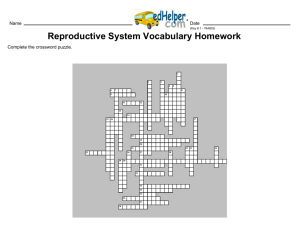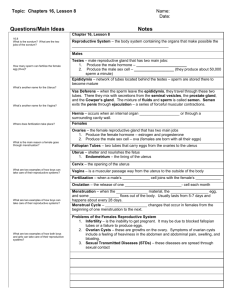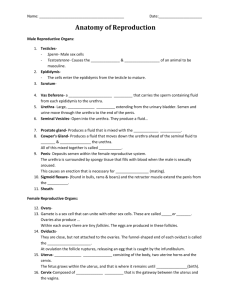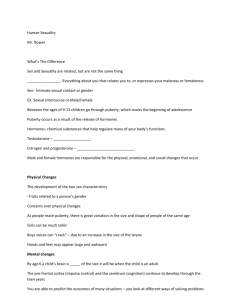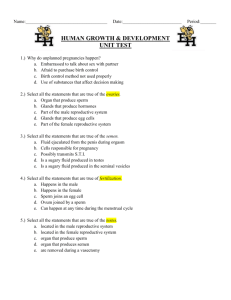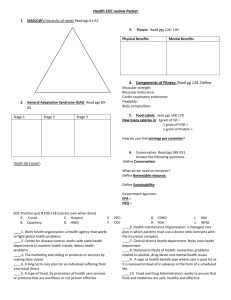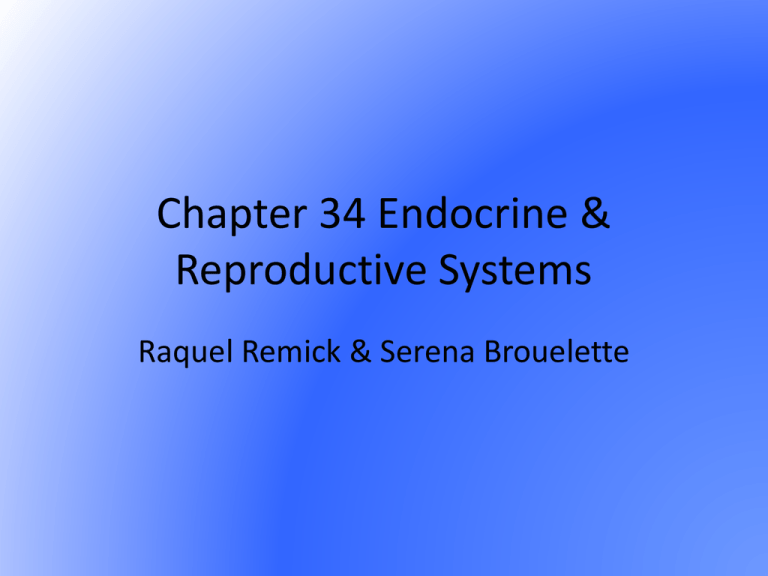
Chapter 34 Endocrine &
Reproductive Systems
Raquel Remick & Serena Brouelette
Sections 34.1-34.2
Endocrine System
• The function of the endocrine system is to
produce chemical messengers (hormones)
from glands to regulate certain body activities.
Roles of endocrine glands:
• Pituitary: controls other glands
• Pineal: regulates sleep and wake cycles, along with other basic
functions
• Hypothalamus: controls secretions of the pituitary gland
• Thyroid: regulates metabolism
• Parathyroid: maintains homeostasis in blood calcium levels
• Adrenals: helps body prepare for and deal with stress
• Pancreas: releases insulin and glucagon to regulate level of glucose in
blood
• Ovaries (female): produces eggs and estrogen to create female
characteristics
• Testes (male): produces sperm and testosterone to create male
characteristics
Sections 34.3 & 34.4
Reproductive System
Structures of the male reproductive system:
• Testes: primary male reproductive organ;
produces sperm and releases hormone
testosterone
• Scrotum: sac that houses the testes; it can raise
or lowers to adjust the temperature so that it is
optimal for sperm development
• Epididymis: comma shaped structure found on
outside of testes; sperm travel here from testes
to mature
• Vas deferens: tube leading to the epididymus
to urethra; stores sperm until they are
released from the body
• Seminal vesicles: first gland that sperm pass
on their way out of the body; secretes a liquid
containing fructose to nourish sperm and give
them energy needed to swim
• Prostate gland: next gland; secretes an
alkaline substance that makes up most of the
seminal fluid; this fluid protects sperm from
acid in male urethra and increases motility
• Bulbourethral gland: last gland; small and
closest to urethra; secretes an alkaline
substance often secreted before ejaculation to
prepare urethra for sperm
• Urethra: passageway leading from bladder to
exterior of body; common outlet for semen
and urine
• Penis: organ through which urine or semen
must pass to exit the body; organ by which
semen is introduced to female vagina
• Glans penis: enlarged end of penis; the head
• Ejaculation: when male is sexually aroused,
autonomic nervous system prepares male
organs to deliver sperm; smooth muscles
lining glands of reproductive tract contract
and eject sperm from male body; If sperm
are released into reproductive tract of
female, chances of one sperm finding an egg
are quite good
Structures of the female reproductive system:
• Ovaries: primary female reproductive organs;
produce eggs and release estrogen
• Fimbrae: fingerlike projections that accept the
egg from the ovary to to the Fallopian tube
• Fallopian tubes: tube that carries mature egg
from ovary to uterus; place where fertilization
ocurs
• Uterus: hollow muscular cavity that receives
the fertilized egg and where the fetus
develops; where the egg disintegrates if not
fertilized
• Cervix: lower portion of uterus; opening that
leads to the vagina
• Vagina: passageway that leads from uterus to
outside body; where babies pass through to
be born and male’s penis is introduced
• Vulva: collective term for the external
reproductive organs of the female
• Clitoris: small organ made of erect tissue;
homologous to the head of the penis
• Endometrium: the lining of uterus; each
month it becomes thick to prepare for
fertilization; sloughed off if no fertilizations
• Ovulation: process of releasing an egg from
the ovary
4 Phases of Menstrual Cycle
•
•
•
•
Follicular
Ovulation
Luteal
Menstruation
Zygote’s Early Development
• Initially the zygote is a single cell just the size of a
dot
• At four days, embryo is about 64 cells
• 6-7 days after fertilization, embryo implants into
uterine wall
• Placenta forms by 3rd week. It is the organ
through which mother and child exchange gases
and nutrients; the blood of the mother and infant
do not actually mix, but flow past each other and
gases and nutrients diffuse across thin
membranes
• The amniotic sac also develops, which is a
fluid filled sac that protects the baby within
the uterus.
• After 4 weeks, the heart starts beating
• After 6 weeks, limb buds appear
Later Stages of Development
• By 3 months, most of the baby’s major organs
have formed.
• During 2nd trimester, the mother starts to
visibly look pregnant, the fetal heartbeat can
be heard from a stethoscope, and mother can
feel fetus move
• In the 3rd Trimester, the organ systems mature
and the fetus doubles in size.
Childbirth
• After 9 months, the child is fully developed
and ready to be born.
• Oxytocin is released, which causes
contractions of the uterine walls.
• Cervix opens
• Amniotic sac breaks
• The after-birth follows: the placenta, amniotic
sac, and umbilical cord still attached


